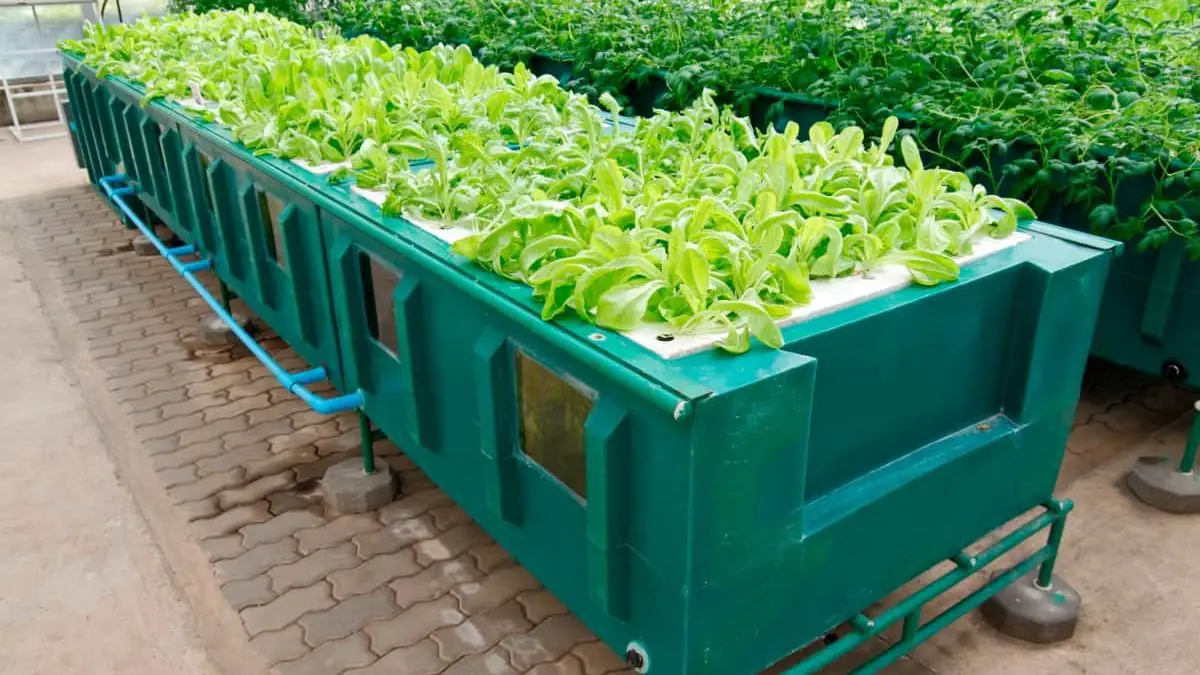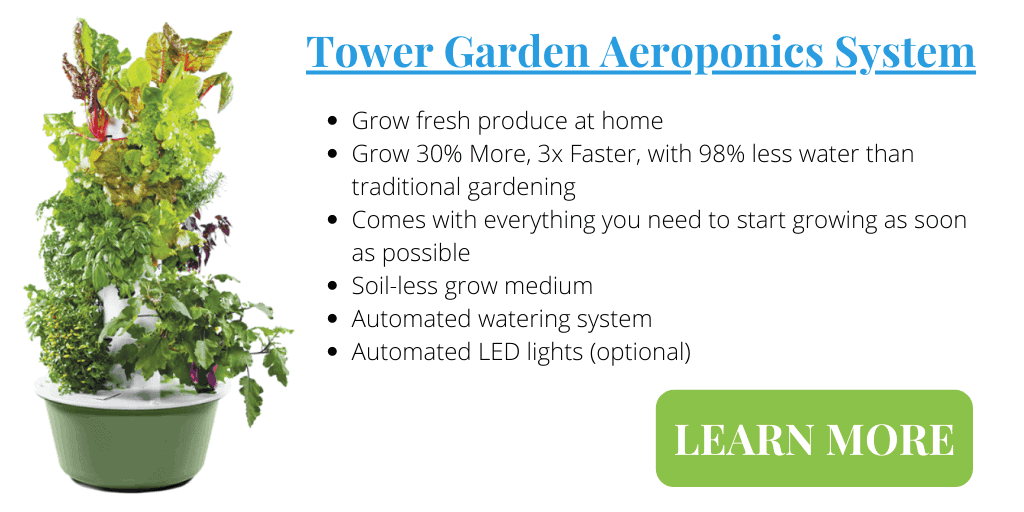Deep water culture hydroponics is one of the simplest forms of hydroponics, but it can become more complicated when implemented on a large scale. Some of the hydroponics system names may sound very scientific and a little daunting for those new to hydroponics. The principles behind the techniques are not rocket science and can be mastered by anyone.
Deep water culture hydroponics, or DWC, is a hydroponic system where the plant is grown suspended above the nutrient reservoir. The plants’ roots are in constant contact with the nutrients, which requires no pumps to circulate the water. The nutrient solution is aerated with an air stone and air pump.
Deep water culture hydroponics is a popular implementation of hydroponics because of its simplicity and the potential to scale the system up for commercial growing volumes. You can make DWC as simple or as complicated as your needs require. Its advantages make it a great hydroponics system to start with if you want to dabble in the world of hydroponic growing!

Deep Water Culture Hydroponics (DWC) Explained
There are many different implementations of hydroponics, and deep water culture is one of the easiest to start and maintain, making it popular for beginners and experienced hydroponic growers.
You may even have explored deep water culture hydroponics without realizing it. Many people have tried growing large avocado seeds suspended on the top of a glass jar with toothpicks and the lower part of the seed resting in the water below.
Growing avocado seeds using this method essentially uses deep water culture hydroponics in its simplest form. Learn more about growing avocados with hydroponics in my article, Can You Grow an Avocado With Hydroponics?
Deep Water Culture is one of many different hydroponic growing methods. Find out which methods will work best for you in my article that explains everything about different hydroponic systems.
The Principles Of Deep Water Culture Hydroponics
DWC hydroponics seeks to offer the plants easy access to the two main components they need to grow healthy and strong and produce a good yield.
The two components the plants need access to are as follows:
- Dissolved nutrients. The plants have easy access to nutrients dissolved in water in the nutrient reservoir.
- Oxygen. There are two ways of providing oxygen to plants in a DWC system, depending on the system’s complexity.
The principles driving the deep water culture or DWC growing method are simple and easy to set up for a home grower to try out. Even though the principles may be basic, they must be followed to ensure this method’s success. There are many off the shelf DWC systems that can have you growing fast and easy at home.
Deep water culture hydroponics consists of an upper structure that supports the plants directly above the nutrient solution, often in hydroponic net pots. In some implementations of the DWC system, there is an air gap between the plants and the nutrient solution, while in others, there is no air gap.
The plant roots will hang directly in the nutrient solution, allowing them to absorb nutrients at their own pace and not have to work hard to find nutrients in the soil.
In a simple implementation with only one plant in a container, the air gap is usually sufficient to allow the roots above the water to absorb oxygen for the whole plant.
In larger systems, the oxygen is usually supplied by an air stone which bubbles air through the water, allowing the oxygen to dissolve into the nutrient solution.
Large commercial operations may use liquid oxygen to provide more efficient water oxygenation and have better control over the process. This system is too expensive to implement for hobbyist growers.
- 8" bucket basket to hold your choice of growing medium
- Multi-purpose air hose delivers air from the pump to the bottom of the bucket
- Air pump to oxygenate your water to encourage root growth
Commercial DWC Growing
In commercial applications of DWC hydroponics, you may hear the system referred to as Deep Flow Technique (DFT) or Floating Raft Technique (FRT). In these implementations, the plants are grown in floating polystyrene rafts with the roots hanging into the nutrient solution through holes in the polystyrene.
The rafts are floated in large rectangular tanks, which allows the plants to be moved to different parts of the grow tank at different stages of growth. This production line of floating rafts makes the process of seed germination, seedling growth, and harvesting easy and efficient.
What Is RDWC Hydroponics?
An adaptation of DWC hydroponics is RDWC hydroponics, where the “R” stands for recirculating. This technique does not use a single nutrient reservoir but implements several reservoirs, all interconnected and connected to a central nutrient reservoir.
As with any hydroponics system, some variations can adapt the system to make it more suitable for different circumstances.
In traditional DWC systems, each system must be monitored and maintained to present the correct pH, nutrient concentration, and water temperature. This task can become a chore if you grow 20 or more plants, each in its own DWC system.
The RDWC system simplifies the monitoring and maintenance of a single reservoir that feeds multiple plant systems. This adaptation is particularly useful for growing plants with the same nutrient and growing requirements and managing the environment from a single location; the central reservoir.
The downside to the RDWC system is that if you mess up the nutrient solution of the pH or water temperature, you can damage or kill many plants in one go, increasing your losses.
Recirculating deep water culture hydroponics is sometimes called modular DWC since the system contains several reservoirs connected to the main reservoir storage.
The easiest method I’ve used to grow greens, strawberries and herbs at home is with the Tower Garden vertical aeroponic system. The system works on a preset timer that controls the nutrient pump and makes the system nearly maintenance free.
Within an hour of receiving the tower at my front door I was able to start planting seedlings and start the growing process. My plants grow faster than any other system I’ve tried and because I can grow 20+ plants in a very small footprint. Get more information in my review of the Tower Garden vertical growing system.

Advantages Of Deep Water Hydroponics
There are many benefits to growing hydroponically using the DWC system, making it popular for commercial and hobbyist growers.
The main benefits of the deep water culture hydroponics system include the following.
- Scalability. The DWC system is scalable, so you can start small while you become familiar with the principle and management and ramp up your system to a larger scale to produce a higher yield.
- Low cost. Some of the components required to set up a DWC system can be made from standard household items, and the other components are inexpensive to buy.
- Low maintenance. DWC hydroponic systems are relatively easy to monitor and maintain, especially the simple implementations.
- Less to go wrong. The system’s simplicity means that the DWC is a robust form of hydroponics with relatively little that can go wrong regarding equipment failure.
- Fast food production. Due to the controlled nature of the growing environment and the ready access to nutrients, the plants mature much faster and produce a crop much faster than growing in soil.
Disadvantages Of Deep Water Hydroponics
Although deep water culture hydroponics is a stable, reliable system, it does have some challenges in keeping the growing environment within the best range for the plants.
Many of the issues will depend on the size of the system and the location where the DWC system is situated. The following are the main problem areas of DWC hydroponics.
- Difficulty maintaining nutrient temperature. If the system is outdoors, the nutrient reservoir can absorb heat and become too hot very quickly in the summer months. In winter, indoor and outdoor systems will require heating to maintain the correct temperature of the nutrient solution. In large systems, heating large volumes of water can be costly.
- Over or under-adjusting system parameters. If the DWC system is small, it is very easy to over or under-adjust the pH, nutrient level, or temperature, which can be detrimental to the plants.
- Burning the plant roots. Since the plant’s roots are in direct contact with the nutrient solution, the roots can easily be burned if the nutrient solution is made too strong. This can damage or kill the plants.
- Air pump failure. The air pump is a single point of failure. If a failed pump goes unnoticed for a few days, the plants can become starved of oxygen, and their health will decline rapidly.
DWC Growing Environment Parameters
As we have seen in the disadvantages of DWC systems, you need to keep the growing environment within a range of parameters to provide the best conditions for the plants to thrive.
PH, water temperature, water level, and nutrient concentration are the main parameters. The following parameter range list can be used as a basic guideline to ensure your system provides the ideal growing environment for your plants.
- DWC nutrient temperature. The temperature of the nutrient solution in the reservoir will affect how effectively the plants can absorb nutrients. The ideal range is between 60°F and 68°F or 16°C and 20°C.
- Nutrient pH level. Adding nutrients to water can affect the pH level, as can the plants as they change their growth cycle. The water in your area may also have a less than ideal natural pH. The best pH range to aim for is between 5.5 and 6pH, which is the optimal range for nutrient uptake for the roots. This may vary depending on the types of plants growing in the system, so check the best pH level for each crop.
- Nutrient concentration. The best method to measure nutrient concentration is using a digital EC meter. Dip the meter probes in the solution, and it will give you a reading of the dissolved solids in the solution. The required level varies for different types of plants, but the general range is between 1.5 and 2.2 units on the EC meter, equivalent to 1000ppm to 1500ppm
- Water level. If the nutrient reservoir water level drops too low, the plant roots can dry out, and they may not have enough access to sufficient nutrients, which will cause the plants to die. Visual monitoring of the water level every couple of days is sufficient to avoid this problem. The water level should also not be too high. At least 1-inch to 1.5-inches of the upper parts of the roots should be exposed to air.
What You Need To Set Up A DWC Hydroponics System
You need some basic gear to set up a DWC hydroponic system, but to try it out, you can use equipment you can find around your house with the addition of a few cheap components.
The main part of the system is a container with a lid. The lid will become the support structure for the plants, while the container’s body will be the nutrient reservoir.
The containers can be any food-safe plastic container large enough for the plants you want to grow. It is best to choose a deep container rather than a shallow, flat container to give the plant’s roots space to grow down into the nutrients. A shallow container also increases the risk of the water level dropping too quickly and the roots drying out.
Besides the container, you will need to purchase a few relatively inexpensive items.
- Air pump. An air pump with an airstone can be purchased at most pet stores in the aquarium section.
- Net pots. These will be the pots suspended in the lid to hold your plants. The net pots come in a range of sizes for different size plants and can be found online, in garden centers and from hydroponic supply shops.
- Grow medium. Coconut coir, rock wool, or peat moss are the favored growing materials to support the plant in the net pot. The grow mediums can be purchased online or at any garden center.
- An EC meter and pH meter. You can purchase an integrated EC and pH meter, and they will generally have a built-in thermometer to give readings of the water temperature.
- Hydroponic nutrients. There are various nutrients you can buy to get started. Liquid nutrients are easiest, but powdered nutrients offer better value for money.
For more information check out my recent article on selecting hydroponic nutrients for growing fruits and vegetables.
This list may seem extensive, but the parts are not expensive. You can purchase all these items and have your DWC system set up for under $50, depending on the size you are aiming for.
Building A DIY Deep Water System
If you are creating a DIY system, you must cut holes in the plastic container’s lid, which will be large enough to support the rim of the net pot.
It would be easiest to start with seedlings rather than growing from seeds as a beginner. Wrap the seedlings in the growing medium and place them in the net pots. Position the net pots in the reservoir’s lid with sufficient spacing to give the plants room when they mature.
Fill the reservoir with fresh, clean water, preferably non-chlorinated. If you only have chlorinated water, fill the reservoir the night before and let it stand open overnight. The chlorine will out-gas into the atmosphere.
The water level should contact the bottom of the net pot so the growing medium can wick nutrients up to the seedling until the roots have grown long enough to reach the reservoir. You can lower the water level as the roots extend past the bottom of the net cup.
Mix the nutrients and add them to the water. Test the nutrient levels, pH level, and temperature. Place the lid on the reservoir and give the seedlings time to settle in. Keep monitoring the system parameters daily for the first few days.
What Can You Grow In Deep Water Culture Hydroponics?
The easiest plants to grow in deep water culture hydroponics are leafy green plants or non-fruiting plants.
Lettuce, spinach, and swiss chard all make good starter crops to learn DWC hydroponics. Herbs such as basil, mint, chives, sage, and thyme are also easy to grow using this method.
It is possible to grow fruiting plants such as chilies, tomatoes, peas, and beans in a deep water culture system, but these take a little more effort and care. Consequently, you should only give these plants a go in your DWC system once you have some experience with growing the leafy plants.
It is a good general practice to grow plants in the same system that have the same nutrient and pH requirements to keep the monitoring and maintenance of the system as simple as possible.
Conclusion
Deep water culture hydroponics is an easy and successful form of hydroponics that any gardener can implement and have good success with the system.
The low-maintenance and limited equipment needed to get started makes it the ideal system for home growers to implement to grow food easily and efficiently and increase the crop yield in their available space.
The scalability of the system makes DWC hydroponics the ideal system for people new to this growing method as well as commercial growers of high-volume food crops.

